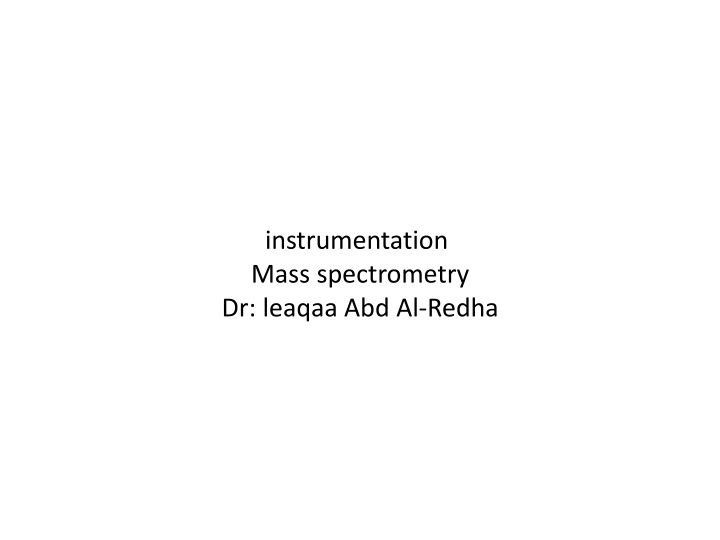
Understanding Mass Spectrometry: Powerful Analytical Technique
Mass Spectrometry (MS) is a potent analytical technique used to determine molecular weight, molecular formula, and structural information of compounds through fragmentation patterns. The mass spectrometer functions by subjecting molecules to high-energy electrons, ionizing them, and separating the ions based on their mass-to-charge ratio. The technique provides crucial data for identifying compounds and studying their properties, making it a valuable tool in various fields such as chemistry, biochemistry, and forensics.
Download Presentation

Please find below an Image/Link to download the presentation.
The content on the website is provided AS IS for your information and personal use only. It may not be sold, licensed, or shared on other websites without obtaining consent from the author. If you encounter any issues during the download, it is possible that the publisher has removed the file from their server.
You are allowed to download the files provided on this website for personal or commercial use, subject to the condition that they are used lawfully. All files are the property of their respective owners.
The content on the website is provided AS IS for your information and personal use only. It may not be sold, licensed, or shared on other websites without obtaining consent from the author.
E N D
Presentation Transcript
instrumentation Mass spectrometry Dr: leaqaa Abd Al-Redha
* (MS) is super potent technique - To give M.Wt -molecular formula - Elements represent - structural information (fragmentation pattern)
The mass spectrometer performs 3 essential functions: 1stit subjects molecules to bombardment by stream of high energy electrons, converting some of molecules to ions which accelerated in an electric field. 2nd,the accelerated ions are separated according to their m/z ratio in a magnetic or electric field. Finally,the ions that have a particular m/z ratio are detected ,amplified and recorder then give mass spectrum
Basic principle: a charged particles moving in a magnetic field *degree of deflection depends on mass/charge - heavier molecule more charged = deflected more - deflected less
Probably the most useful information you should be able to obtain from a MS spectrum is the molecular weight of the sample. This will often be the heaviest ion observed from the sample provided this ion is stable enough to be observed
Electron Ionization (EIMS): the basic idea ,wn can used one electront to ionized the molecule M + e M +2e - if you take CH4
The order of energy required to remove electron is as follows : electron non-conjugated > conjugated > non bonding or lone pair of electrons
* Most molecules show a peak for the molecular ion, the stability of which is usually in the order : Aromatic > Conjugated acyclic polyenes> Alicyclics > n- hydrocarbons > ketones > ethers > Branched chain hydrocarbons > Alcohols
2- Heterolytic cleavage: *Alkyl halide : * Alcohol: = * Ethers
* Rearrangement reactions accompanied by transfer of atoms: 1- Scrambling fragmentation giving rise to stable carbocation: ex- M from Alkyl benzen undergoes at benzylic bond and final product is 7 membered cyclic ion known as Tropylium ion
3- McLafferty rearrangement: (intramolecular atomic rearrangment) * must have -H = an unsaturation point
Isotopes - most elements common to organic cpds r mixtures of isotopes. - the existence of atomic isotopes in nature accounts for the appearance of M+1 and M+2 peaks in a mass spectrum. - organic cpds containing only C,H,O and N usually have relatively small M+1 and M+2 Peaks.
ISOTOPES: MS is particularly valuable for cpds w contain Cl and Br: - if one S atom is present,M+2 is 4% of M - if one Cl atom is present, M+2 is 33% of M - = = Br atom is present ,M+2 is to M
Carbone rule: * for cpds containing only C,H and O the following formula can be used to determine the # C in the molecule:
Can determine the molecular formula of unknown organic cpd whose mass spectral data is given in the table below:
Nitrogen rule: - if a cpd with even # N(no N or even)= give even (M ) , - if cpd with odd # N= (M ) will be odd ex: C2H5NH2 H2NCH2CH2NH2 (CH3)3CH M =58 M = 45 M =60
